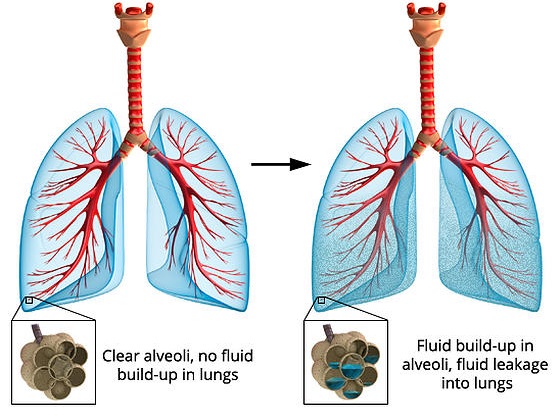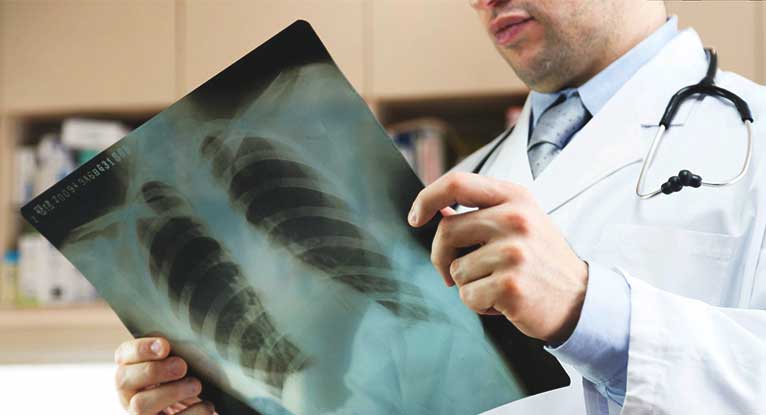 The lungs are located within the chest, just under the rib cage. They are critical for breathing in oxygen and expelling carbon dioxide. Compared to other organs in the chest, the lungs are considered relatively large. They are located on either side of the heart in two cavities. Although at first glance the two cavities look identical, the right cavity is made up of three lobes and the left cavity is made up of two lobes. Each of the lobes is composed of clusters of alveoli or air sacs, which is where the gases are exchanged and then oxygen is taken up by the bloodstream for transport throughout the body.
The lungs are located within the chest, just under the rib cage. They are critical for breathing in oxygen and expelling carbon dioxide. Compared to other organs in the chest, the lungs are considered relatively large. They are located on either side of the heart in two cavities. Although at first glance the two cavities look identical, the right cavity is made up of three lobes and the left cavity is made up of two lobes. Each of the lobes is composed of clusters of alveoli or air sacs, which is where the gases are exchanged and then oxygen is taken up by the bloodstream for transport throughout the body.
The process of breathing is continuous provided if the alveoli are intact and functioning normally. However, the accumulation of fluid in the lungs, also called pulmonary edema, compromises the lung's ability to uptake oxygen and to expel carbon dioxide. Pulmonary edema is a medical condition that is characterized by the abnormal accumulation of fluid in the lungs, inflammation of the lungs, and difficulty breathing. This article will explore the symptoms, causes and treatment strategies for pulmonary edema.
Symptoms of Fluid in Lungs
Fluid in the lungs can cause a host of symptoms. These symptoms vary based on whether the fluid accumulation occurred suddenly (acute) or the fluid accumulation was an ongoing phenomenon (chronic). The symptoms of acute and chronic fluid in the lungs are listed below:
Symptoms of Acute Fluid in the Lungs
- Difficulty breathing (dyspnea) or severe shortness of breath that is exacerbated by lying down
- Feeling of drowning or suffocating
- Gasping for breath and wheezing
- Uneasiness or restlessness
- Coughing up blood-tinged frothy sputum
- Sweating in excess
- Pale skin
- If the fluid in the lungs is due to heart disease, it may cause chest pain
- Heart palpitations (irregular, accelerated heartbeat)
It is important to remember to seek immediate medical attention by calling 911 if you experience any of the symptoms that are characteristic of acute fluid in the lungs.
Symptoms of Chronic Fluid in Lungs
- Difficulty breathing exceeds normal expectations following physical activity
- Increased difficulty breathing when lying flat compared to sitting up
- Wheezing
- Waking up at night feeling breathless, which can only be relieved when you sit up
- Rapid weight gain and swollen legs/ankles due to the accumulation of fluid in the body. This is caused by congestive heart failure, which refers to impairments in the ability of the heart to pump sufficient blood throughout the body.
- Reduced appetite.
- Lethargy.
Causes of Fluid in the Lungs
Cardiogenic (Heart-related) Causes
Fluid in the lungs that occurs as a result of heart defects is known as cardiac pulmonary edema or congestive heart failure. The left ventricle of the heart receives oxygenated blood from the lungs, which it then pumps out to the rest of the body. When the left ventricle is damaged by disease or overworked, it is unable to completely pump out the blood that it received from the lungs, thus increasing the pressure inside the left atrium, the veins, and finally in the capillaries of the lungs. Eventually the blood is forced through the capillary walls into the alveoli. Another cause of congestive heart failure include left heart failure, due to pulmonary hypertension or chronic lung disease, which increases the pressure within the pulmonary artery to levels that cannot be controlled by the right ventricle.
Some medical conditions that can lead to left ventricle failure include:
- Coronary artery disease. Heart muscles can become damaged when their blood supply is blocked by fatty deposits and blood clots. The heart becomes weakened and its ability to efficiently pump out blood is compromised, causing blood to leak through the capillaries into the alveoli.
- Cardiomyopathy. Cardiomyopathy refers to damage to the heart muscle that is not caused by compromised blood flow. With cardiomyopathy, the left ventricle is weakened and the heart tries to compensate by increasing blood pressure, beating faster, and using excessive amounts of salt. Eventually, the left ventricle is unable to pump out the blood and fluid builds up in the lungs.
- Heart valve problems. The mitral valve and aortic valve control blood flow into and out of the left side of the heart, respectively. Diseases to these valves that prevent them from opening wide enough (stenosis), closing completely (insufficiency), or narrowing, allow blood and pressure to build up in the left ventricle. To compensate, the left ventricle dilates and pumps less efficiently, which causes the muscle to thicken and weaken.
- Hypertension (high blood pressure). Untreated or uncontrolled high blood pressure causes a thickening of the left ventricular muscle, and worsening of coronary artery disease.
Non-Cardiogenic Causes
Conditions that cause fluid in lungs that are not related to the heart are known as non-cardiac pulmonary edema. In these conditions, the alveoli or capillaries become leaky allowing fluid to accumulate in the lungs. Non-cardiac pulmonary edema is caused by a number of factors, including:
- Lung infections. Bacterial infections of the lung, such as pneumonia, can cause sections of the lungs to swell and edema to develop in that area.
- Exposure to toxins. Inhaled toxins, including chlorine and ammonia, as well as toxins from your body (inhaled vomit) can cause fluid in the lungs.
- Kidney disease. If your kidney function becomes compromised and it is unable to excrete waste efficiently, then your body can retain water leading to pulmonary edema.
- Smoke inhalation. The chemicals contained in smoke can damage the lining of the alveoli and the capillaries and fluid can enter the lungs.
- Adverse drug reactions. A variety of illegal drugs (heroin and cocaine) and medications (aspirin and chemotherapy drugs) can damage the lining of the alveoli and allow fluid in the lungs.
- Acute respiratory distress syndrome (ARDS). Severe traumatic injuries, sepsis, pneumonia or shock can trigger the sudden infiltration of white blood cells into the lungs along with fluid buildup in the lungs.
- High altitudes. High-altitude pulmonary edema (HAPE) can develop in mountain climbers, hikers, skiers, or people that travel to or reside in high-altitude locations that are above 8,000 feet (about 2,400 meters) without first becoming acclimated. HAPE causes constriction of the pulmonary capillaries and increased pressure. HAPE can be fatal if not treated appropriately.
- Near drowning. During the process of drowning water is inhaled and the lungs become filled with the water. Immediate medical attention is required to drain the lungs.
Treatments for Fluid in the Lungs
The initial intervention for fluid in the lungs is the administration of oxygen, either via a mask covering the nose and mouth or cannula (a device with flexible tubing with two pieces that are inserted into the nostrils). In some extreme cases, it needs to use a ventilator to supplement the breathing process.
In addition to the oxygen, it may also be necessary to administer one or more of the medications listed below:
Medical Treatments
- Preload reducers. The pressure caused by fluid in the lungs can be alleviated by medications called preload reducers. Furosemide (Lasix), which is a diuretic, triggers urination to get rid of excess fluid. Nitroglycerin is a drug that causes blood vessels to dilate. These drugs work to lower the fluid in the heart, which in turn can help to lower the fluid in the lungs.
- Morphine (Astramorph). Although the narcotic morphine can alleviate anxiety and difficulty breathing, some doctors choose to use other drugs because of they may feel that the dangers exceed the benefits of morphine.
- Afterload reducers. Medications such as nitroprusside (Nitropress), enalapril (Vasotec) and captopril (Capoten) are examples of afterload reducers. These drugs alleviate the pressure in the left ventricle by triggering blood vessels to dilate.
- Hypertension medications. Hypertension (high blood pressure) may cause fluid to accumulate in the lungs. Conversely, low blood pressure may also cause fluid buildup in the lungs. To relieve the fluid in the lungs your doctor may give you drugs to lower or raise your blood pressure as needed.
- Treating fluid in the lungs due to high-altitude. Fluid in the lungs due to high- altitude is also known as high-altitude pulmonary edema (HAPE). If you begin to experience symptoms of HAPE you should descend 600 - 900 feet to lower altitude as soon as possible. In some cases you should take oxygen. More severe cases of HAPE may require an airlift. To prevent or treat HAPE symptoms, climbers may take acetazolamide (Diamox) at least three days prior to their ascent. Acetazolamide functions similar to a diuretic in that it triggers the body to get rid of excess fluid. Some of the side effects associated with acetazolamide are diarrhea, confusion, nausea, hearing problems, burning of the feet and hands, and reduced appetite.
Home Remedies
If you have non-cardiac pulmonary edema, you may be able to prevent additional damage to your lungs by avoiding the factors that may have triggered your condition, including drugs, allergens or high altitudes. Here are few home remedies that you can try to prevent or treat some of the factors that eventually lead to fluid in lungs:
- Monitor your weight daily. Before eating breakfast in the morning, you should measure your weight. If you notice a weight gain of 2 to 3 pounds (1 to 1.4kg) in one day you should see your doctor.
- Maintain the diet set by your doctor. People that have been diagnosed with cardiac pulmonary edema are typically placed on a low-salt diet. You can get help from a dietitian to determine the salt content in most foods. It is suggested that the person who prepares the meals meets with the dietitian so that they get an understanding of the meal plan. If you eat out at restaurants, you should be aware that restaurant food is typically high in salt. In addition, you should use diet and exercise to reach your ideal weight
- Lower your high blood pressure. Talk with your doctor about your optimal blood pressure and test your blood pressure at home daily to make sure that it is appropriate.
- Listen to medical advice. Your doctor will likely recommend ways to control your underlying health problems. They may counsel you on your diet, weight and physical activity level.
- Get plenty of sleep each night. You should get at least 8 to 9 hours of sleep per night and you should nap during the day as needed. Snoring and symptoms of obstructive sleep apnea can interrupt your sleep. If this is the case you consider being evaluated at a sleep center.
